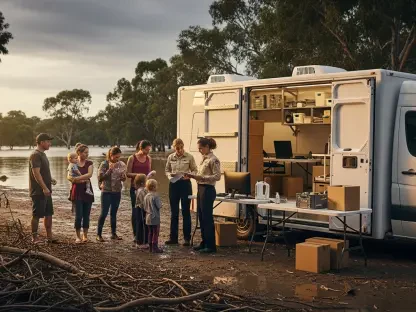In the wake of devastating natural disasters, a troubling trend has emerged across the United States, leaving countless homeowners in vulnerable positions as insurance companies pull back from high-risk regions. From the hurricane-battered shores of Florida to the wildfire-prone hills of California, residents are finding themselves without the safety net of insurance coverage at a time when they need it most. This growing crisis stems from the increasing frequency and intensity of climate-driven weather events, which have upended traditional risk models that insurers once relied upon. As a result, many companies are either canceling policies outright or hiking premiums to unaffordable levels, forcing homeowners to bear the full brunt of potential losses. This issue not only threatens individual financial security but also raises broader questions about how communities can adapt to a changing environment where protection against disaster is becoming a luxury few can afford.
The Impact of Extreme Weather on Insurance Availability
The surge in extreme weather events has fundamentally altered the landscape of insurance coverage in many parts of the country. Hurricanes, wildfires, and tornadoes have become more frequent and severe, leading to unprecedented levels of property damage that insurers struggle to cover. In areas like Sanibel Island, Florida, the aftermath of powerful storms has resulted in staggering claim payouts through programs like the National Flood Insurance Program (NFIP), dwarfing historical figures. This shift has made it clear that past weather patterns, once a reliable guide for setting premiums, no longer hold true. Insurers, facing mounting losses, are increasingly opting to withdraw from regions deemed too risky, leaving homeowners stranded. The financial toll on individuals is immense, as many lose not only their homes to disaster but also the means to rebuild without insurance support. This growing gap in coverage highlights a critical challenge for communities already grappling with the physical and emotional scars of natural catastrophes.
Moreover, the ripple effects of this insurance retreat extend beyond individual households to entire local economies. When homeowners cannot secure coverage, property values often plummet, and rebuilding efforts stall, creating ghost towns out of once-thriving neighborhoods. The burden falls heavily on those least equipped to handle it, as low- and middle-income families find themselves unable to afford skyrocketing premiums or self-insure against potential losses. In states prone to specific disasters, such as California with its wildfires, the absence of insurance options compounds the difficulty of maintaining a stable community. This systemic issue reveals how deeply intertwined environmental changes are with financial security, as the inability to obtain coverage undermines the very foundation of homeownership for many. Addressing this crisis requires more than temporary fixes; it demands a reevaluation of how risk is assessed and shared in an era of escalating natural threats.
Climate Change as a Driving Force Behind Policy Cancellations
Scientific consensus points to climate change as a key factor intensifying the weather events that are pushing insurance companies out of high-risk areas. The burning of fossil fuels and other human activities have contributed to rising global temperatures, resulting in more powerful storms, prolonged droughts, and other destructive phenomena. NASA and other research bodies have documented how these changes amplify the frequency of disasters, creating a cycle of damage that insurers find unsustainable. As claims soar, companies are forced to reassess their exposure, often choosing to cancel policies rather than absorb continuous losses. This trend is evident not just in coastal regions battered by hurricanes but also in inland areas facing increased tornado activity. Homeowners, caught in the crosshairs of these environmental shifts, are left with few options to protect their investments, underscoring the urgent need for broader systemic adjustments.
Beyond the immediate impact on policy availability, the connection to climate change raises critical questions about long-term adaptation and responsibility. As weather events grow more unpredictable, the traditional models of risk assessment used by insurers become obsolete, leading to a patchwork of coverage that excludes the most vulnerable regions. This dynamic creates a vicious cycle where lack of insurance discourages mitigation efforts, such as building resilient infrastructure, which in turn heightens future risks. Communities in disaster-prone areas are thus trapped between environmental realities and financial constraints, with little recourse to break free. The broader implication is that without significant intervention, the gap between those who can afford protection and those who cannot will widen, exacerbating social and economic inequalities. Tackling this issue requires not only addressing emissions and climate impacts but also rethinking how insurance can function in a world of escalating hazards.
Exploring Solutions for a Growing National Crisis
Amid the mounting challenges, various stakeholders are exploring potential solutions to stabilize insurance access for homeowners in high-risk zones. One prominent idea is expanded federal intervention, building on frameworks like the NFIP to offer more comprehensive coverage where private insurers have retreated. Such programs could provide a safety net, ensuring that residents are not left entirely unprotected against disasters. Additionally, some states are pushing for legislative reforms to hold insurance companies accountable, imposing penalties for abrupt policy cancellations and encouraging fairer practices. These efforts aim to balance the needs of homeowners with the financial realities faced by insurers, creating a more equitable system. While these proposals are still in early stages, they represent a critical step toward addressing a problem that affects millions across diverse regions of the country.
Furthermore, long-term strategies must focus on integrating climate resilience into both insurance models and community planning. Encouraging investments in disaster-resistant infrastructure and incentivizing sustainable practices could reduce the overall risk profile of vulnerable areas, making them more attractive to insurers. At the same time, public-private partnerships might offer innovative ways to share the burden of coverage, blending government support with industry expertise. These approaches, though complex, are essential for adapting to an environment where extreme weather is no longer an anomaly but a recurring reality. As discussions around these solutions gain momentum, the emphasis remains on finding actionable paths forward that prioritize homeowner security without placing undue strain on any single sector. The road ahead will require collaboration and compromise, but the stakes—ensuring that communities can withstand and recover from disasters—could not be higher.
Reflecting on Past Struggles and Future Pathways
Looking back, the struggles of homeowners in high-risk areas paint a stark picture of vulnerability as insurance companies retreat from regions battered by relentless natural disasters. The personal losses endured by residents, coupled with the systemic failures of coverage, underscore a national crisis that demands urgent attention. Yet, amidst these challenges, glimmers of hope emerge through proposed federal programs and state-level reforms aimed at stabilizing the market. Moving forward, the focus must shift to implementing sustainable solutions, such as enhancing climate-resilient infrastructure and fostering public-private collaborations. These steps, though rooted in past lessons, offer a proactive blueprint for safeguarding communities against future threats. Prioritizing equitable access to protection and investing in long-term adaptation will be crucial to ensure that no homeowner is left to face the elements alone.









